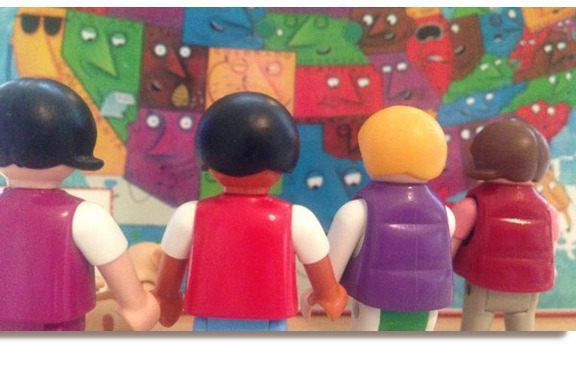KJ Dell’Antonia
By Tamika Thompson | Originally Published at The New York Times. December 6, 2013
Recently, my 27-month-old daughter, Morgan, asked this: “Mommy, can you hand me the black one?”
Sitting with her on the living-room rug amid a mess of plastic building bricks, I realized that she was referring to one of her action figures.
Long before, and apropos of nothing, she had named two of her toys Sonkey and Donkey. And since the ponytail-wearing girl figures look alike, she has always treated them as if they were sisters. But this time, as she set up a colorful birthday party with imaginary cake and balloons for them to enjoy, instead of calling them by the names she had given them, she referred to one of them as “the black one.”
Caught off guard by her distinction, I looked closely and noticed that one had blue eyes and the other brown eyes with slightly darker skin. I panicked. What had my husband and I done as parents that our barely potty-trained daughter was already defining her plastic humanoid toys by color? We don’t allow her to watch television. We had outfitted her play space with multicultural books and toys, and she spends time with a diverse group of playmates. Not once have we said “your white friend” so and so, or “your black friend” such and such, because why would we?
And yet here I was, staring into my daughter’s eyes as one curly lock of hair fell over her furrowed brow, and I was stumped. How would I explain skin color to someone who had just learned the difference between the green and blue crayons?
As I picked up the two figures, I recalled my own confusion after a conversation with my fair-skinned African-American mother that began with me asking, “Mommy, why are you white and I’m black?” and ended with her laughing at me for several minutes. I remembered that I had been shocked and hurt after a conversation with my father about race because he told me that black folks weren’t “worth a damn to white people.”
But I would be different with my daughter, I vowed to myself. I wouldn’t squander this opportunity. I would courageously guide her across this threshold. I glanced at the action figures in my hand, and with the gentlest voice that any early-childhood-development expert would have applauded, I asked, “Morgan, why did you call this one black?”
Her face scrunched up with annoyance. “Because Sonkey has black hair,” she said as she took Sonkey from me. She picked up the other figure. “Donkey has brown hair.”
Of course. Why didn’t I think of that?
I had read several articles about how to address race and ethnicity with children and had committed all of the advice to memory – acknowledge cultural differences as your child becomes aware of them; be accepting of others; use age-appropriate language (whatever that means); and never, ever, ever degrade anyone, because children model behavior more than they listen to rehearsed speeches.
But because I have lived in America as a black person for more than three decades and have amassed hurt feelings, heard misguided conversations on race, as well as endured blatant and vicious racism, I had arrived at a place where I had recited my first race and ethnicity conversation with my daughter again and again in my head, but I hadn’t recited it yet in my heart. I hear “the black one,” and I immediately think – skin color. But Morgan doesn’t. She might one day. But, for now, she doesn’t.
So how will I address skin color, and race, and ethnicity with my daughter when the time really comes? I have no clue, but I hope that I will be honest and raw. I will explain to her that regardless of the countless stereotypes about how unnatural and peculiar we are – how black men are more violent (not true) or virile (also not true), or how black women are so much stronger than other women (hahaha!) – black people are, in fact, the same as everyone else. What’s unnatural is the treatment of black people in this country. What’s peculiar is the categorization of black people as “black.”
And I have a feeling that Morgan will teach me more than I can teach her on the subject, like how to heal. Because, in this post-Trayvon, Obama-led nation, I’m still trying to understand the constructs of race and ethnicity myself.












Leave A Comment